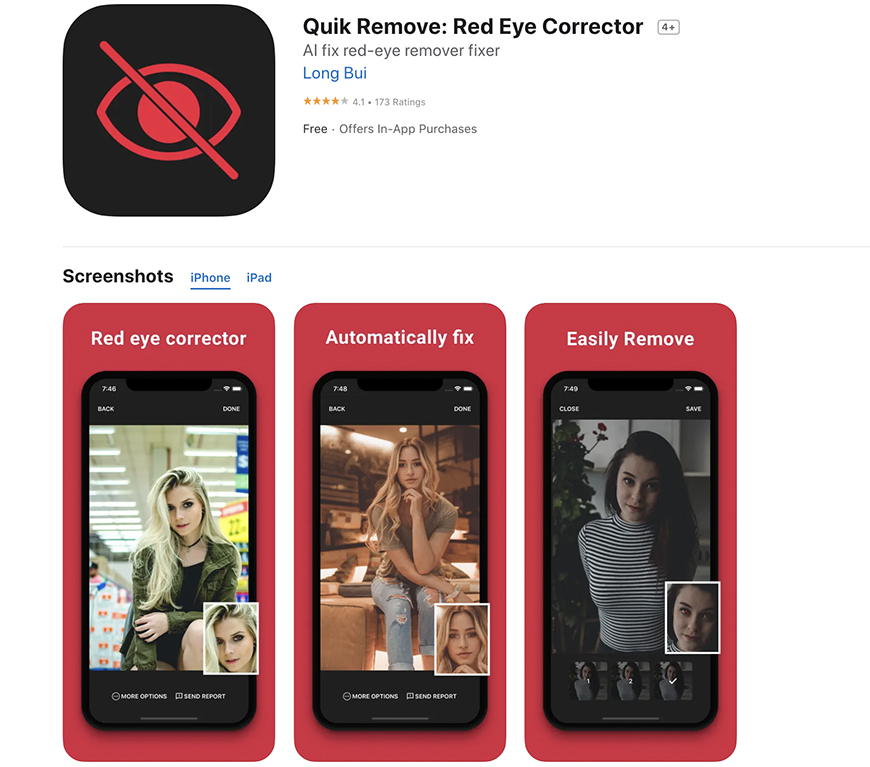
Camera Red Eye: What It Is, How to Avoid It, and How to Fix It
Everything you need to know about camera red eye, including what causes it, ways to avoid it, and how to remove it from your photos.
By Andrew Dilks
Red eye is one of the most common problems in photography, spoiling otherwise great photographs by making the subject’s eyes emit a bright red glow.
I’ve experienced it since using disposable cameras on holiday as a child, and it is familiar to anyone with even a passing interest in photography.
Fortunately, plenty of techniques are available to rectify the problem, from changing the lighting before the photo is taken to modifying the image with post-processing programs.
Read on, and I’ll break down the causes of the red eye effect and the different methods you can use to ensure this doesn’t affect your photographs.
What Causes Camera Red Eye?

Credit: PeterPan23 via Wikimedia Commons
The red eye effect in pictures occurs when the light rays from your camera’s flash reflect back off the subject’s retina and into the camera lens.
The underlying choroid, which contains connective tissue between the retina and the white of the eye, is composed of lots of blood vessels that create the effect.
When bright light hits the eye, the pupils widen, causing the light to reach the retina and bounce back as red light, resulting in the red eye effect.
There are also rare instances when this is caused by an eye condition or due to misaligned eyes, in which case you should seek consultation with an eye doctor.
Rare infections aside, most instances can be put down to a combination of low light and the camera’s flash and can be resolved with a range of simple solutions.
How to Prevent Camera Red Eye When Taking Photos
While red eyes in photos are an unwelcome addition to your photos, fortunately, there are various steps you can take to prevent it.
These include changing the way you approach flash photography to using a variety of post-processing techniques to remove them after the fact.
Tip 1: Increase the ambient light in the room

Credit: Ruben Ramirez
Low-light photography with camera flashes can be easily addressed by increasing the amount of light to prevent the subject’s pupils from opening wide.
Turning on lights will help make the room brighter and give you enough light to shoot the image without the need for your flash.
Tip 2: Ask the subjects to avoid looking directly into the camera

Credit: Foto Sushi
Since the primary cause of the red eye effect is due to the subject looking directly into the camera, asking them to stop doing this is an obvious solution.
Request that they look slightly to the side of the camera lens, and this will prevent reflected light from directly off the retina leading to red eyes.
Tip 3: Move the flash away from the camera lens

Credit: Kevin Yudhistira Alloni
If you’re using a camera with an external flash, detach this from the camera body and move it away from the lens to prevent light from reflecting from the pupils.
Bear in mind this method isn’t possible for internal flash cameras, but if you’re using higher-end equipment, it’s an easy solution to this perennial problem.
Tip 4: Use the anti-red eye function on your camera’s built-in flash

Credit: Coccoparisienne
Most modern cameras have a built-in anti-red eye feature that you can use to eradicate red eyes from your photographs.
The function emits an additional flash to restrict the pupils before the photo is taken, allowing the second flash to occur before they can re-dilate.
How to Remove Camera Red Eye from Photos
If you’ve already taken photos with red eyes on your subjects, there are several steps you can take to remove red eyes and create frame-worthy photographs.
Let’s take a closer look at some of the simple post-processing techniques you can use to remove red eye from your photographs.
How to Remove Red Eye From Photos Taken with Your Camera

Credit: EmDee via Wikimedia Commons
There is a range of excellent post-processing programs photographers use to create visual images that pop off the page or screen.
These programs can also be used for more prosaic tasks such as removing red eye, with specific tools built in dedicated to fulfilling this task.
Adobe’s Lightroom post-processing program, one of the most popular on the market, includes a Red Eye Correction tool as part of its Develop module.
Simply switch to the Develop module and click the Red Eye Correction tool, then draw a circle over the affected eye and adjust the settings until the red eye disappears.
There’s also an option to remove Pet Eye, which works like the Red Eye Correction tool for editing photos of your cats and dogs.
If you don’t have Lightroom, there are similar tools in GIMP, which is a free post-processing program you can use if you’re on a tight budget.
To remove red eyes with GIMP, open up the program’s filters and go to Enhance, then select Red-eye removal and move the threshold slider until the red is removed.
How to Remove Red Eye From Photos Taken with Your Android Smartphone or iPhone

If you’re struggling with red eyes on photos you’ve taken on your smartphone, there are a number of apps you can use to remove the effect.
iPhone users can install the Quik Remove: Red Eye Corrector application from the Apple Store, which uses AI-based recognition tools to remove red eyes from photos instantly.
There’s also a basic tool in the built-in photo editing software, which can be accessed via the Edit option and by choosing the Red Eye tool.
Android smartphone users are also well served with apps they can use to remove red eye, for example using the Red Eye remover in the Photo Editor.
Other free apps compatible with iOS and Android devices you can use to remove red eye include Adobe Photoshop Express, Visage, and Pixlr.
How to Remove Red Eye From Printed Photos
Removing red eye from photos you’ve already printed out requires a different approach, and you’ll need a specially-designed retouching pen to do this.
You can purchase a red eye photo retouching pen relatively cheap, and it uses a unique dye that transforms the emulsions into a more natural colour.
Alternatively, you can scan the photos into your computer, then use one of the post-processing programs outlined above, reprinting the image once it has been corrected.
FAQ
Are red eyes in photos normal?
Red eyes in photos might be an unwelcome addition to photos, but they are a normal reaction when the camera flash reflects off the retina, which is rich in blood vessels.
It is especially common when using an external flash in a poorly-lit environment, such as outdoors during the evening or in a nightclub.
What is red eye reduction in digital camera?
Most modern digital cameras include an anti-red eye function to minimize or completely remove the red eye effect from your photos.
This feature is integrated into the camera’s flash setting, which fires the flash twice to affect the blood-rich retina in the subject’s pupils in the photo.
The first flash causes the subject’s pupils to contract, with a second flash used to capture the photo with no red eye effect present.
Why are only some people in a group photo affected by the red-eye effect?
Several factors impact whether or not red eye is present in a photo, with the main factor being the subject is staring directly into the lens.
People suffering from eye diseases such as cataracts, or misalignment of their eyes due to strabismus, are also more prone to the red eye effect.
What does it mean if you have only one red eye in a photo?
If red eye is only showing in one eye in photos, it could be due to the aforementioned misalignment of the subject’s eyes.
It can also occur when someone is off-center from the camera so that one eye is looking directly into the camera lens and the other is slightly askew.
What if one eye is red and the other eye appears bright yellow or white?
The appearance of a single red eye alongside an eye with a white or yellowish glow may be a warning sign that the person is suffering from leukocoria.
It can also indicate retinal detachment, cataracts, Coats’ disease, and even the rare childhood cancer called retinoblastoma.
If this effect occurs in photographs your child’s eyes, seek consultation with an optician immediately to treat the ailment.
Why do my cat’s eyes shine different colors in photos?
Cats have much larger eyes than humans, and when the light from your flash hits the tapetum lucidum, it bounces back and creates a green glare.
Some breeds of cats, such as Siamese cats, will emit a yellow glow based on the amount of riboflavin or zinc present in the tapetum lucidum pigment cells.
Does drinking alcohol contribute to red-eye?
Consumption of alcohol reduces the physiological response time in people, including how quickly the eyes respond to bright light.
As a consequence, the red eye effect is more likely to occur when photographing subjects who have consumed alcohol using the camera flash.


Check out these 8 essential tools to help you succeed as a professional photographer.
Includes limited-time discounts.













